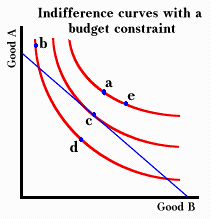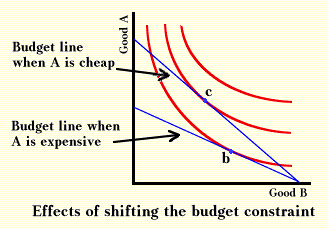Deriving Demand
(This section is takes one a bit beyond where one needs to go in introductory economics, but it illustrates how indifference curves are used.)
To show what the consumer should do to maximize utility, a budget line must be added to the preferences shown in the indifference curves. The picture below adds one. Point a is not attainable because it lies to the right of the budget line. The consumer is indifferent between points b and d because they lie on the same indifference curve, but point d is cheaper than b because d lies below the budget line. The consumer wants to get on the highest indifference curve affordable, and this will lead him to point c.

The effect of a rise in the price of good A is shown on the graph below. A higher price of A means that less of A can be purchased, and hence the budget line moves to the left, intersecting the vertical axis at a lower point. Point c is no longer possible and the consumer must move to a new position, which, assuming utility maximization, will be point b. Unless the indifference curves are peculiar, point b will represent less of good A than will point c, which is what the law of demand says will happen.

Looking at two different prices has produced two different points on an individual's demand curve. By varying the price of good A, other points could be found and an entire demand curve for one individual consumer constructed. The market demand curve is obtained by adding up the demand curves of all individuals.
The theory of consumer choice that the indifference curves embody is an elegant construction with which economists frame problems. One of its weaknesses is that a great many outcomes are consistent with it--though a downward-sloping demand curve can be derived from it, so too can an upward sloping demand curve. Further, in recent years there has been a realization among economists that pictures such as those above may not be a good description of the decision-making process when people must make decisions with partial information, with fuzzy goals, under conditions of risk and uncertainty, and when options are difficult to compare. Finally, there do seem to be cases in which people systematically violate the rules that this theory says are rational.
Copyright Robert Schenk